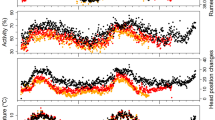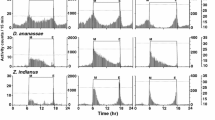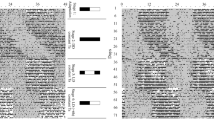Abstract
The locomotory activity rhythms of Asian garden dormice, Eliomys melanurus from Saudi Arabia were investigated under controlled laboratory conditions. Animals were maintained under different lighting conditions for a period of two weeks each. Dormice exhibited predominantly nocturnal activity during the light/dark (LD) (mean % nocturnal activity: 95.5 ± 0.9%) and dark/light (DL) (mean % nocturnal activity: 96.8 ± 0.7%) light cycles. All animals expressed free-running rhythms of locomotor activity when subjected to constant darkness (mean τ: 24h06 ± 0h09). Upon inversion of the LD cycle to DL, activity re-entrained to the new light cycle within 3 days. When the dark component of the day was lengthened to 8L:16D the active time increased significantly from 11h43 ± 0h05 to 13h43 ± 0h22. In contrast, when the dark component was shortened from 12L:12D to16L: 8D, the active time decreased significantly to 7h58 ± 0h04. No difference was apparent in the locomotor activity at 20 and 30 °C however, dormice became very inactive at 10 °C.
Overall, locomotor activity patterns of the Asian garden dormouse largely resemble those of other species of dormice. However, Asian garden dormice spent long periods of time inactive both during light and darkness, when exposed to an ambient temperature of 10 °C, which may be related to the dramatic and sudden change in temperature. This period of inactivity may reflect a bout of torpor or the entering into a state of hibernation.
Similar content being viewed by others
References
Abulfatih, H.A., 1979. Vegetation of higher elevation of Asir, Saudi Arabia. Proc. Saudi Biol. Soc. 3, 139–148.
Abulfatih, H.A., 1981. Wild plants of Abha and its surroundings. Proc. Saudi Biol. Soc. 5, 143–159.
Amori, G., Aulagnier, S., Hutterer, R., Krystufek, B., Yigit, N., Mitsain, G., Palomo, L.J., 2008. Eliomys melanurus. In: IUCN 2012. IUCN Red List of Threatened Species. Version 2012.2, https://doi.org/www.iucnredlist.org
Aschoff, J., 1979. Circadian rhythms: influences of internal and external factors on the period measured in constant conditions. Z. Tierpsycol. 49, 225–249.
Aschoff, J., 1981. Free-running and entrained circadian rhythms. In: Aschoff, J. (Ed.), Handbook of Behavioural Neurobiology, vol. 4. Plenum Press, New York.
Aschoff, J., Hoffmann, K., Pohl, H., Wever, R., 1975. Re-entrainment of circadian rhythms after phase-shifts of the zeitgeber. Chronobiologia 2, 23–78.
Bertolino, S., 2007. Microhabitat use by garden dormice during nocturnal activity. J. Zool. 272, 176–182.
BirdLife International, 2012. Important Bird Areas factsheet: Raydah escarpment, Downloaded from https://doi.org/www.birdlife.org (17.06.12).
Bright, P., Morris, P., 2006. Why are dormice rare? A case study in conservation biology. Mamal. Rev. 26, 157–187.
Bright, P., Morris, P., Wiles, N.J., 1996. Effects of weather and season month summer activity of dormice Muscardinus avellarius. J. Zool. 238, 521–530.
Cohen, R., Kronfeld-Schor, N., 2006. Individual variability and photic entrainment of circadian rhythms in golden spiny mice. Physiol. Behav. 87, 563–574.
Daan, S., 1973. Periodicity of heterothermy in the garden dormouse, Eliomys quercinus (L). Neth. J. Zool. 23, 237–265.
Daan, S., Albrecht, U., Van der Horst, G.T.J., Illnerová, H., Roenneberg, T., Wehr, T.A., Scwartz, W.J., 2001. Assembling a clock for all seasons: are there M and E oscillators in the genes? J. Biol. Rhythms 16, 105–116.
Duma, I.I., Giurgiu, S., 2012. Circadian activity and nest use of Dryomys nitedula as revealed by infrared motion sensor cameras. Folia Zool. 61, 49–53.
Froy, O., 2007. The relationship between nutrition and circadian rhythms in mammals. Front. Neuroendocrinol. 28, 61–71.
Gür, M.K., Bulut, Ş., Gür, H., Refinetti, R., 2013. Body temperature patterns and the use of torpor in an alpine glirid species, woolly dormouse. Acta Theriol., https://doi.org/dx.doi.org/10.1007/s13364-013-0154-159.
Haim, A., Rubal, A., 1995. Thermoregulation and rhythmicity in Eliomys melanurus in the Negev highlands, Israel. Hystrix 6, 209–216.
Harrison, D.L., 1972. The Mammals of Arabia, Vol. 3 Lagomorpha and Rodentia. Ernest Benn. Ltd, London.
Harrison, D.L., Bates, P.J.J., 1991. The Mammals of Arabia. Harrison Zoological. Museum Publications, Sevenoaks, Kent, UK.
Ivashkina, V.A., 2006. Abundance and activity of the edible dormouse (Glis glis L.) in the Zhiguli mountains (Rushia Middle Volga region). Pol. J. Ecol. 54, 337–344.
Jallageas, M., Assenmacher, I., 1983. Annual plasma testosterone and thyroxine cycles in relation to hibernation in the edible dormouse Glis glis. Gen. Comp. Endocrinol. 50, 452–462.
Jallageas, M., Assenmacher, I., 1984. External factors controlling annual testosterone and thyroxine cycles in the edible dormice Glis glis. Comp. Biochem. Physiol. A Comp. Physiol. 77, 161–168.
Jallageas, M., Assenmacher, I., 1986. Effects of castration and thyroidectomy on the annual biological cycles of the edible dormouse Glis glis. Gen. Comp. Endocrinol. 63, 301–308.
Jallageas, M., Mas, N., Assenmacher, I., 1989. Further demonstration of the ambient temperature dependence of the annual biological cycles in the edible dormouse, Glis glis. J. Comp. Physiol. B 159, 333–338.
Janin, H., Besheer, M., 2003. Saudi Arabia: Cultures of the World. Times Books International.
Jud, C., Schmutz, I., Hampp, G., Oster, H., Albrecht, U., 2005. A guideline for analyzing circadian wheel-running behavior in rodents under different lighting conditions. Biol. Proc. Online 7, 101–116.
Juskaitis, R., 2005. Daily torpor in free-ranging common dormice (Muscardinus avellanarius) in Lithuania. Mamm. Biol. 70, 242–249.
Juskaitis, R., 2008. The Common Dormouse Muscardinus avellanarius: Ecology, Population Structure and Dynamics. Institute of Ecology of Vilnius University, Vilnius, Lithuania.
Kastenmayer, R.J., Moak, H.B., Jeffress, E.J., Elkins, W.J., 2010. Management and care of African dormice (Graphiurus kelleni). J. Am. Assoc. Lab. Anim. Sci. 49, 173–176.
König, C., 1960. Einflüsse von licht und temperatur auf den winterschlaf des sieben-schläfers Glis . glis (Linnaeus 1766). Z. Morph. Ökol. Tiere 48, 545–575.
Meijer, J.H., Rietveld, W.J., 1989. Neurphysiology of the suprachiasmatic circadian pacemaker in rodents. Phyisol. Rev. 69, 671–707.
Montoya, R., Ambid, L., Agid, R., 1979. Torpor induced at any season by suppression of food proteins in a hibernator, the garden dormouse (Eliomys quercinus L.) Comp. Biochem. Physiol. 62 (A), 371–376.
Nevo, E., Amir, E., 1964. Geographic variation in reproduction and hibernating patterns of the forest dormouse. J. Mamm. 45, 69–87.
Nowak, R.M., 1999. Walker’s Mammals of the World. The John Hopkins University Press, Baltimore, MD.
Nowakowski, W.K., 1998. 24-Hour activity in the forest dormouse (Dryomys nitedula). Nat. Croat. 7, 19–29.
Ognev, S., 1963. Mammals of U.S.S.R. and Adjacent Countries—Rodent, vol. 5, Israel Program for Scientific Translations, Jerusalem.
Okamura, H., Yamaguchi, S., Yagita, K., 2002. Molecular machinery of the circadian clock in mammals. Cell Tissue Res. 309, 47–56.
Otsu, R., Kimura, T., 1993. Effects of food availability and ambient temperature on hibernation in the Japanese dormouse, Gliurus japonicus. J. Ethol. 11, 37–42.
Pajunen, I., 1984. Ambient temperature dependence of the periodic respiratory pattern during long-term hibernation in the garden dormouse. Eliomys quercinus L. Ann. Zool. Fennici 21, 143–148.
Pajunen, I., 1986. Ambient temperature dependence of physiological parameters during long term hibernation in the garden dormouse, Eliomys quercinus. In: Assenmacher, I., Boissin, J. (Eds.), Endocrine regulations as adaptive mechanisms to the environment. Editions du Centre National de la Recherche Scientifique, Paris, pp. 379–383.
Panchetti, F., Amori, G., Carpaneto, G.M., Sorace, A., 2004. Activity patterns of the common dormouse (Muscardinus avellanarius) in different Mediteranean ecosystems. J. Zool. Lond. 262, 289–294.
Pittendrigh, C.S., Minis, D.H., 1964. The entrainment of circadian oscillations by light ad their role as photoperiodic clocks. Am. Nat. 98, 261–294.
Pittendrigh, C.S., Daan, S., 1974. Circadian oscillations in rodents: a systematic increase of their frequency with age. Science 186, 548–550.
Pittendrigh, C.S., Daan, S., 1976. A functional analysis of circadian pacemakers in nocturnal rodents, VI. Entrainment: pacemaker as a clock. J. Comp. Physiol. 106, 291–331.
Pohl, H., 1968. Wirkung der Temperatur auf die mit Licht synchronisierte Aktiv-itätsperiodik bei Warmblütern. Z. Vergl. Physiol. 58, 381–394.
Pohl, H., 1987. Circadian pacemaker does not arrest in deep hibernation, evidence for desynchronization from the light cycle. Experimentia 43, 293–294.
Popescu, A., Murariu, D., 2000. Fauna României, Mammalia, Rodentia, vol. XVI, fasc. 2. Editura Academiei Române.
Quintero, J.E., Kuhlman, S.J., McMahon, D.G., 2003. The biological clock nucleus: a multiphasic oscillator network regulated by light. J. Neurosci. 23, 8070–8076.
Refinetti, R., 2006. Circadian Physiology, 2nd ed. CRC Press/Taylor & Francis Group.
Reppert, S.M., Weaver, D.R., 2002. Coordination of circadian timing in mammals. Nature 418, 935–941.
Rodolfi, G., 1994. Dormice Glis glis activity and hazelnut consumption. Acta Theriol. 39, 215–220.
Saint Girons, M.C., Lenkiewicz, Z., 1965. Variations annuelles de l’activite chez Dryomys nitedula (Pallas 1778) en captivite. Folia biologica 13, 23–39.
Skene, D.J., Lockley, S.W., Thapan, K., Arendt, J., 1999. Effects of light on human circadian rhythms. Reprod. Nutr. Dev. 39, 295–304.
Stephan, F.K., Zucker, I., 1972. Circadian rhythms in drinking behavior and locomotor activity of rats are eliminated by hypothalamic lesions. Proc. Natl. Acad. Sci. U.S.A. 69, 1583–1586.
Strauss, M., Sher Shah, M., Shobrak, M., 2008. Rodent trapping in the Saja/Umm Ar-Rimth protected area of Saudi Arabia using two different trap types. Zool. Middle East 43, 31–39.
Tavernier, R.J., Largen, A.L., Bult-Ito, A., 2004. Circadian organization of a subarctic rodent, the northern red-backed vole (Clethrionomys rutilus). J. Biol. Rhythms. 19, 238–247.
Vietinghoff-Riesch, A., 1960. Der Siebenschläfer (Glis glis L.) ‒ Monographien der Wildsäugetiere vol. 14. Gustav Fischer Verlag, Jena, pp. 196.
Webb, P.I., Skinner, J.D., 1996. Summertorporin African woodland dormice Graphiurus murinus (Myoxidae: Graphiuridae). J. Comp. Physiol. B. 166, 325‒330.
Weber, E.T., Hohn, V.M., 2005. Circadian activity of the spiny mouse, Acomys cahirinus. Physiol. Behav. 8, 27‒433.
Weisgerber, D., Redlin, U., Mrosovsky, N., 1997. Lengthening of circadian period in hamsters by novelty-inducing wheel running. Physiol. Behav. 62, 759‒765.
Welsh, D.K., Logothetis, D.E., Meister, M., Reppert, S.M., 1995. Individual neurons dissociated from rat suprachiasmatic nucleus express independently phased circadian firing rhythms. Neuron 14, 697‒706.
Wilson, D., Reeder, D., 2005. Mammal Species of the World. Johns Hopkins University Press, Baltimore.
Author information
Authors and Affiliations
Corresponding author
Rights and permissions
About this article
Cite this article
Alagaili, A.N., Mohammed, O.B., Bennett, N.C. et al. Now you see me, now you don’t: The locomotory activity rhythm of the Asian garden dormouse (Eliomys melanurus) from Saudi Arabia. Mamm Biol 79, 195–201 (2014). https://doi.org/10.1016/j.mambio.2013.10.001
Received:
Accepted:
Published:
Issue Date:
DOI: https://doi.org/10.1016/j.mambio.2013.10.001




